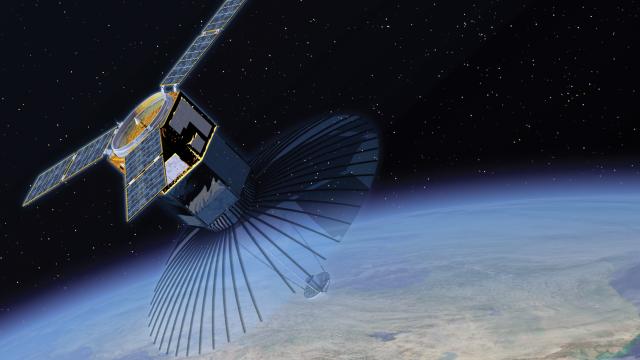The unfolding drama between Russia and the Ukraine along the Crimean peninsula is developing, rapidly and unpredictably — certainly not in-sync with the orbits of our overhead surveillance assets. But if we could somehow get a few purpose-built (and presumably rapidly-prototyped) cube sats up there, the US Air Force could place extra eyes in the sky on-demand, and keep a closer watch on what’s happening on the ground. And that’s where Northrop Grumman’s new Modular Space Bus comes in.
The Modular Space Bus (MSV) is just what it sounds like, it’s an intermediary transport for tiny satellites between the launch rocket and their new orbits. See, you can’t just strap a bunch of cube sats to the back of a Minotaur rocket and hope for the best; there needs to be a secondary launch vehicle that puts them into the proper orbital flight path once they’re free of gravity’s grasp. The MSV is that vehicle.
This is not science fiction or some blue sky, drawing-board concept, mind you. Northrop Grumman has already delivered the first system to the USAF after designing and building the MSV in just 30 months for $US50 million. It will be operated by the Air Force’s Operationally Responsive Space Office (ORS) out of Kirtland Air Force Base, N.M. to launch of smaller, disposable satellites for short-term missions — we’re talking a matter of days or weeks at most. Potential mission types might include radar imaging, missile warning, military communications, and “weather studies”.
“Because MSV is the first to implement space plug-and-play standards with simplified, standard hardware and software interfaces, the bus is loaded with flexibility,” said Doug Young, vice president, Missile Defense and Advanced Missions, Northrop Grumman Aerospace Systems. Loaded. With flexibility.
Marketing jargon aside, the MSV’s modular nature really is quite flexible. Sensors and payloads can easily be swapped in and out to meet the specific mission requirements, while its standardised hardware and software requirements ensure that no matter which company makes the payload, every component will work in unison.
“MSV provides ways for future development of rapid response space capabilities that will be timely, cost-efficient and flexible,” said Doug Young, vice president, Missile Defense and Advanced Missions, Northrop Grumman Aerospace Systems, said in a press statement. “A satellite bus contains the support structure and control subsystems that allow the payload to perform its mission.”
What’s more, the MSV itself is able to operate at low, medium, and geosynchronous orbits and can hitch a ride on a number of different rocket types including the Minotaur I and IV. Plus it can easily don and shed batteries and solar arrays to suit the mission. If only this thing were recoverable and reusable, it’d be perfect. [WSJ – UPI – Northrop Grumman – Defense Systems]
